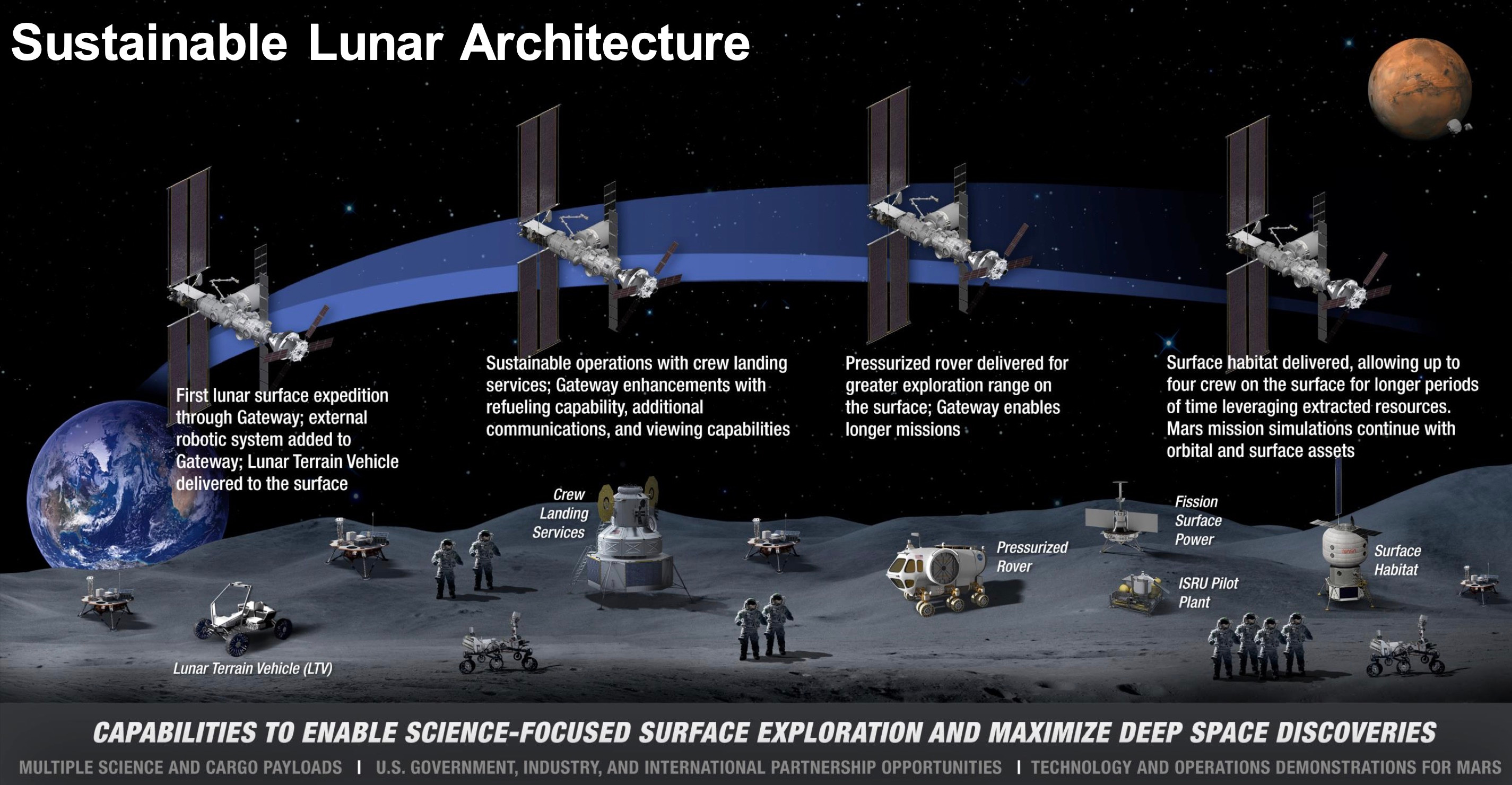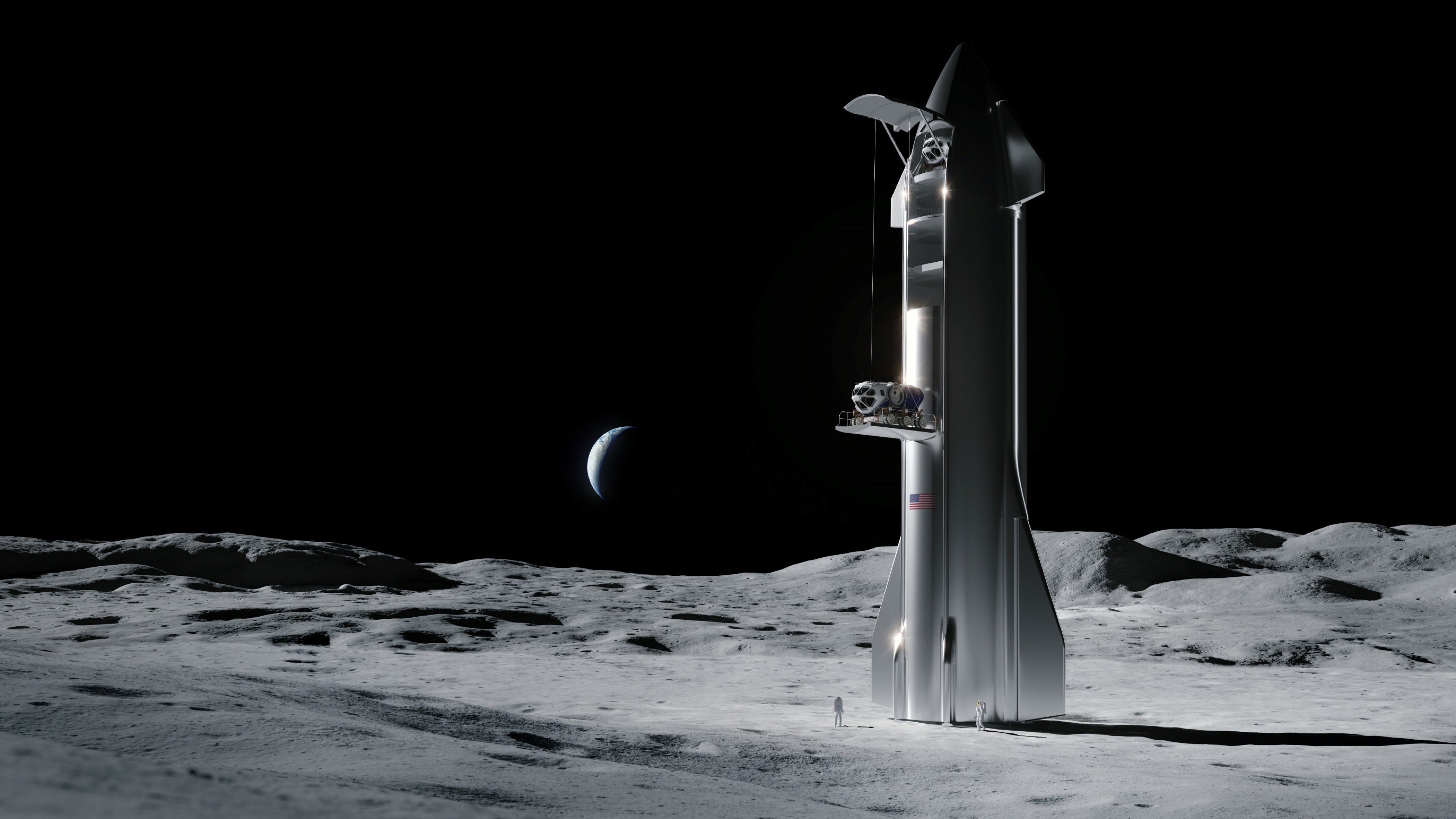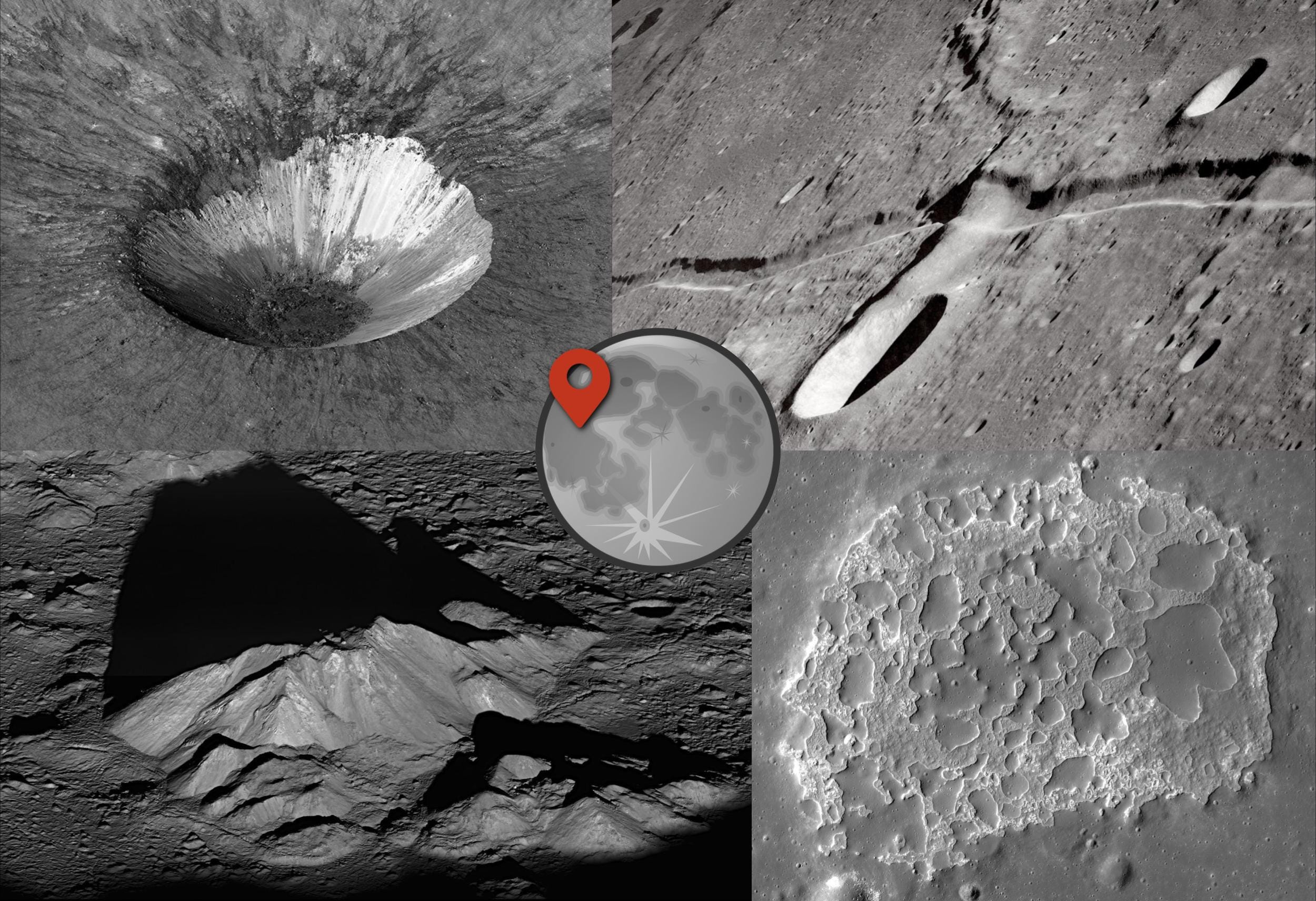Moon Monday #78: NASA’s Lunar-Mars vision, forward planning Artemis I, and more lunar updates
Mapping NASA’s Moon to Mars objectives to efforts on Earth
On May 17, NASA released a draft set of 50 one-liner, high-level Moon to Mars objectives, notably the first time anything specific on the matter has been put out publicly. The objectives, aimed at establishing a permanent human presence on the Moon first and Mars after, are placed into the following four overarching categories:
- Transportation and Habitation
- Lunar and Mars infrastructure
- Operations
- Science

NASA doesn’t mention on its website or the accompanying announcement the programs and efforts it has already undertaken, and is planning, to meet several of these objectives so I thought it would be useful to map the same. I’m quoting below the in-progress objectives followed by, in italics, their relevant ongoing or upcoming NASA activities along with some commentary. Let me know what you think!
From the 12 objectives under Transportation and Habitation:
TH-1: Develop cislunar systems that crew can routinely operate to lunar orbit and lunar surface for extended durations.
The SLS rocket, Orion spacecraft, an evolved Human Landing System (HLS) with SpaceX (lunar) Starship post Artemis III, and a competitive crewed landing provider from the Sustaining Lunar Development (SLD) program.
TH-2: Develop systems that can routinely deliver large surface elements to the lunar surface.
Cargo variants of the aforementioned HLS and SLD lunar landers. Contributions are also possible from an evolution of NASA’s CLPS program to send instruments and cargo on (currently small) commercial landers, assuming increased funding from the flat-levels in the FY 2023 U.S. Presidential budget request. Note that SpaceX is also among the 14 companies selected by NASA for CLPS, and that the latest Planetary Science Decadal Survey encourages extending the CLPS model to leverage the greatly enhanced capabilities of Starship by setting up funding mechanisms to allow the U.S. scientific community to fly robotic payloads on such high-capacity flights.
TH-3: Develop systems to allow crew to live and operate safely on the lunar surface and lunar orbit for extended periods of time with scalability to continuous presence to visit areas of interest for scientific research, conduct Mars analog activities, support industrial utilization, and conduct utilization activities.
Artemis Basecamp and beyond
TH-4: Develop a habitation system for crew in deep space for extended durations, enabling future missions to Mars.
The NASA-led Gateway lunar orbiting station, for the former part of the objective anyway.
TH-9: Develop integrated human and robotic systems with inter-relationships that enable maximum science return from the lunar surface and from lunar orbit.
A reference to hybrid missions like the Endurance-A rover recommended in the latest Planetary Science Decadal Survey.
TH-11: Develop systems capable of returning large cargo mass from the lunar surface to the Earth, including the capabilities necessary to meet scientific sample return objectives.
Aforementioned HLS and SLD landers. There has been chatter about evolving CLPS for sample return missions but it sadly remains fictitious.
From the 4 objectives under Lunar Infrastructure:
LI-1: Develop an incremental lunar power grid that is evolvable to support continuous human/robotic operation and is capable of scaling to global power utilization and industrial power levels.
No overarching project exists for this yet but there have been some bits of NASA-funded developments like lunar polar solar panel design work and Sandia’s initial microgrid design for Artemis Basecamp.
LI-2: Develop Lunar surface, orbital, & Lunar to Earth communications, position, navigation and timing architecture capable of scaling to support long term science, exploration, and industrial needs.
LunaNet, which still hasn’t been formally approved yet unlike ESA’s similar Moonlight initiative.
From the 11 objectives under Operations:
OP-3: Characterize accessible lunar resources, gather scientific research data, and analyze potential reserves to satisfy science and technology objectives and enable ISRU on successive missions.
The VIPER rover, Lunar Trailblazer orbiter, a 2026 CLPS surface mission featuring Australia’s first lunar rover and ESA’s PROSPECT payload, international missions, and of course initial Artemis crewed surface missions. See Moon Monday #63 for historical context to this push for understanding lunar volatile resources such as water ice.
OP-5: Operate surface mobility systems using extra-vehicular activity (EVA), suits, tools and vehicles.
The upcoming versatile Artemis Lunar Terrain Vehicle and spacesuits, both capable of exploring frigid permanently shadowed regions.
OP-6: Evaluate, understand, and mitigate the impacts on crew health and performance of a long deep space orbital mission, followed by partial gravity surface operations on the Moon.
Gateway and Artemis Basecamp.
OP-8: Demonstrate the capability to find, service, upgrade, or utilize instruments and equipment from robotic landers or previous human missions on the surface of the Moon and Mars.
A very intriguing inclusion.
OP-9: Demonstrate the capability of integrated robotic systems to support and augment the work of crew members on the lunar surface, and in orbit around the Moon.
Planning of hybrid surface sortie missions is a great example of this objective in a scientific context.
From the 8 objectives under Exploration Science:
ES-1: Conduct human field geology on the surface and select high priority sample specimens for return to Earth. | ES-3: Enable in-situ research by delivering science instruments to the lunar surface at various locations and returning high priority samples to Earth. | ES-4: Survey sites, conduct in-situ measurements, and identify/stockpile samples for later astronaut evaluation or retrieval.
Artemis III and subsequent surface crewed missions under the auspices of Artemis Science Teams.
ES-5: Demonstrate retrieval of frozen volatile deep core samples from permanently shadowed regions on the Moon.
Specifically mentioned in the Science Definition report for as soon as the first crewed landing with Artemis III.
ES-6: Establish methods and systems to allow a large number of science instruments to conduct planet-wide long-term measurements.
The Lunar Geophysical Network, as recommended in the latest 2023-2032 Planetary Science Decadal Survey.
From the 4 objectives under Lunar & Planetary Science:
LPS-2: Collect fundamental data to understand the origin, distribution, abundance, composition, transport, and sequestration of volatiles throughout the solar system.
The VIPER rover, Lunar Trailblazer orbiter, international missions like the Chandrayaan 2 orbiter, KPLO and LUPEX, and of course the critical sample return from Artemis crewed surface missions.
LPS-3: Conduct analyses to constrain the chronology and dynamics of early Solar System history, including planetary differentiation, early bombardment history, and the formation of the Earth-Moon system.
Sample return as the key to the Earth-Moon origin and evolution of our solar system
LPS-4: Collect samples over a long traverse/duration in the South Pole Aitken Basin and deliver the samples to astronauts for return to Earth.
A direct reference to the Endurance-A rover recommended in the latest Decadal Survey.
Biological and Physical Science Goal: Understand fundamental biological effects when organisms are present in fractional-gravity and deep-space environments, to gain new scientific understanding and information to guide system development.
Astrophysics Science (AS) Goal: Preserve the far side of the Moon as a “radio-free zone” for future radio astronomy experiments.
AS-1: Monitor the radiofrequency environment on the lunar far side to enable future far side radioastronomy activities.
Related: Map of radio-quietness on the Moon’s farside, and a special issue on the future of astronomy from the Moon published by The Royal Society in November 2020.
That was a long list.
The other objectives in the document will act as guideposts for NASA to formally start programs on. For Mars, the connections between the lunar objectives leading to Mars ones aren’t explicitly made. A lot of the focus seems to be on Mars-analog learnings from lunar missions. This, to me, suggests that NASA isn’t as yet planning much more than a modest crewed landing on Mars, even though that in itself would be an enormous achievement.

All that being said, it isn’t clear why NASA chose to share these objectives now, and is asking for informal feedback from the industry, academia and international communities by May 31 i.e. on a notice of just two weeks. Though NASA will hold workshops with a subset of these industry and international partners in June and July respectively. This will help the agency get a sense of their consensus and identify gaps in the objectives and capabilities needed to meet them, and then integrate the same. Related: Jeff Foust’s timely perspective piece on how NASA is looking to move beyond the traditional contract as Artemis takes shape.
Many thanks to Epsilon3, The Orbital Index and Open Lunar Foundation for sponsoring Moon Monday, which allows me to spend time on such deep dives. The newsletter continues below.

More SLS rocket preparations before key test
NASA is in the final fixes and preparation phase before the SLS rocket heads back to the launchpad in early June for a mid-month wet dress rehearsal test. Notably, engineers took the opportunity to complete early some work to be originally done after the test, such as installing a bunch of hardware on the Orion spacecraft such as the Callisto assistant system and container assemblies for the BioSentinel CubeSat. If the wet dress rehearsal is successful this time around, NASA could launch the Artemis I mission in late August at best. Related: NASA has published an overview of available launch periods for Artemis I from this July 26 to June next year, and launch and orbital constraints that decide the same.
About BioSentinel: It will be the first small satellite to perform a biological experiment in deep space. It will enter solar orbit, and measure the impact of space radiation on yeast over six months. The researchers chose yeast because their cells and human cells have many similar DNA damage and repair mechanisms. Earth-bound research can’t fully simulate the unique radiation environment of deep space so this study will provide us new insights on the deep space radiation effects on biological life as NASA seeks to establish long-term presence on the Moon.
About Callisto: Amazon voice assistant Alexa and Cisco’s Webex video conferencing software will be onboard the Orion spacecraft in the form of a tailor-made tablet and associated hardware. Collectively called Callisto, the system will use NASA’s Deep Space Network for Webex’s video conferencing and Orion’s local database for Alexa to function without an internet. Since Artemis I has no crew, operators will interact with Callisto remotely from the control center on Earth. Specifically with Alexa, the idea is that any crew interfacing with it should be able to access specific real-time mission telemetry data using voice alone. Callisto’s performance on Artemis I will allow for improvements on Artemis II, where actual crew will be present. NASA is also considering using similar technology on the Gateway lunar station.
More Moon
The latest issue of The Orbital Index has more details on the recent research of successfully growing plants in lunar soil. I’m glad that my point about us lacking high-fidelity planetary soil simulants is being carried forward and discussed further in public.
NASA says the CAPSTONE spacecraft, built by Advanced Space, will now launch no earlier than June 6, during a launch period that extends until June 22. The spacecraft safely arrived at the Rocket Lab Launch Complex 1 in New Zealand last week. Rocket Lab completed the launch rehearsal before that, and are now integrating the spacecraft with the Electron rocket and Photon spacecraft bus. The mission intends to prove the feasibility of the unique fuel-saving elliptical lunar orbit that the Gateway will be in later in the decade.
A surreal view of the recent lunar eclipse from 100 million kilometers away by NASA’s Lucy spacecraft.

Credits: NASA Goddard / APL / SwRI Partly inspired by NASA’s Astronomy Picture of the Day (APOD), I made Luna Sights to let people explore interesting geological places on our Moon and learn why we should visit them. Browse a world of craters, mountains, lava channels and more!

